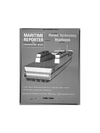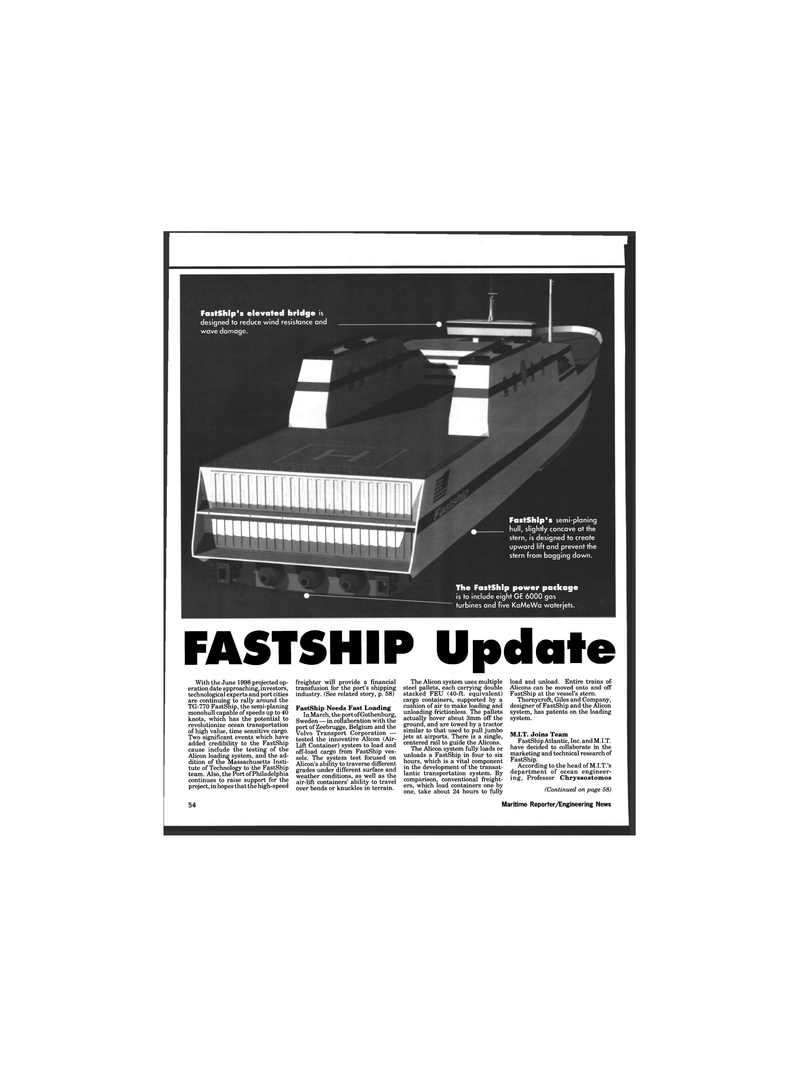
Page 46: of Maritime Reporter Magazine (April 1995)
Read this page in Pdf, Flash or Html5 edition of April 1995 Maritime Reporter Magazine
FastShip's elevated bridge is designed to reduce wind resistance and wave damage. ®""iiiiiiiiiiiiir
FastShip's semi-planing hull, slightly concave at the stern, is designed to create upward lift and prevent the stern from bogging down.
The FastShip power package is to include eight GE 6000 gas turbines and five KaMeWa waterjets.
FASTSHIP Update
With the June 1998 projected op- eration date approaching, investors, technological experts and port cities are continuing to rally around the
TG-770 FastShip, the semi-planing monohull capable of speeds up to 40 knots, which has the potential to revolutionize ocean transportation of high value, time sensitive cargo.
Two significant events which have added credibility to the FastShip cause include the testing of the
Alicon loading system, and the ad- dition of the Massachusetts Insti- tute of Technology to the FastShip team. Also, the Port of Philadelphia continues to raise support for the project, in hopes that the high-speed freighter will provide a financial transfusion for the port's shipping industry. (See related story, p. 58)
FastShip Needs Fast Loading
In March, the port of Gothenburg,
Sweden — in collaboration with the port of Zeebrugge, Belgium and the
Volvo Transport Corporation — tested the innovative Alicon (Air-
Lift Container) system to load and off-load cargo from FastShip ves- sels. The system test focused on
Alicon's ability to traverse different grades under different surface and weather conditions, as well as the air-lift containers' ability to travel over bends or knuckles in terrain.
The Alicon system uses multiple steel pallets, each carrying double stacked FEU (40-ft. equivalent) cargo containers, supported by a cushion of air to make loading and unloading frictionless. The pallets actually hover about 3mm off the ground, and are towed by a tractor similar to that used to pull jumbo jets at airports. There is a single, centered rail to guide the Alicons.
The Alicon system fully loads or unloads a FastShip in four to six hours, which is a vital component in the development of the transat- lantic transportation system. By comparison, conventional freight- ers, which load containers one by one, take about 24 hours to fully load and unload. Entire trains of
Alicons can be moved onto and off
FastShip at the vessel's stern.
Thornycroft, Giles and Company, designer of FastShip and the Alicon system, has patents on the loading system.
M.I.T. Joins Team
FastShip Atlantic, Inc. and M.I.T. have decided to collaborate in the marketing and technical research of
FastShip.
According to the head of M.I.T.'s department of ocean engineer- ing, Professor Chryssostomos (Continued on page 58) 48 Maritime Reporter/Engineering News

 45
45

 47
47
